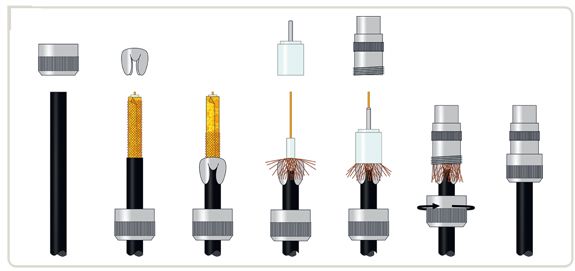Fitting the F-Plug, its a piece of cake
Any changes you wish to make to your Digital TV system usually involve creating new co-ax connections. From the connection to your satellite dish to an aerial cable the correct plugs need to be fitted perfectly otherwise you can be left with a very unsatisfactory signal.
Co-ax Cable elementary
The Aerial Cable or co-ax runs the Digital signal through the centre of the wire. This is insulated against interference by foil or and metal braiding, usually copper, which also acts to carry a return connection. The 2 main plugs or connectors used are the aerial plug (left) used for Terrestrial UHF types of connection. The F-Plug used for satellite systems (centre) & the barrel plug or ( double ended female-female barrel) used to form a join between 2 cables.

a) Cut the cable to length. Allow sufficient for a drip loop for external cables at the LNB.
b) Strip off about 20mm of the cable’s outer plastic sleeve, being careful to not cut through the braid beneath.
c) Peel back the exposed braid and remove the foil underneath.
d) Remove the inner insulator (the dielectric) to leave about 5mm remaining.
e) Screw on the F-plug, clamping the loose braid between the sleeve and the plug body.
f) The plug body should screw all the way onto the cable until the end of the inner insulator contacts or just passes through the baffle inside the plug body.
g) Trim off any exposed braid and cut the inner conductor to just protrude from the end of the plug. Finally, if possible, check the connection along the cable and the isolation between the conductors.
a) Cut the cable to length.
b) Slide the plug cap onto the cable. Strip off about 25mm of the cable’s outer plastic sleeve, being careful to not damage the braid beneath.
c) Slide the collet over the braid to the end of the sleeve. Strip off the braid to leave about 10mm protruding from the sleeve
d) Fold the braid back over the collet. Remove the exposed foil and strip back the inner insulator to leave about 5mm exposed.
e) Push on the pin holder so the cable’s central conductor goes through the pin. If the pin holder has a grub screw to bite into the conductor, tighten this. Otherwise, carefully solder the conductor in the end of the pin.
f) Remove any conductor and solder protruding from the end of the pin. Slide the plug body onto the pin holder.
g) Screw the plug cap onto the plug body, catching the braid and tightening the collet on the cable. Finally, if possible, check the connection along the cable and the isolation between the conductors.




 RSS Feed
RSS Feed
